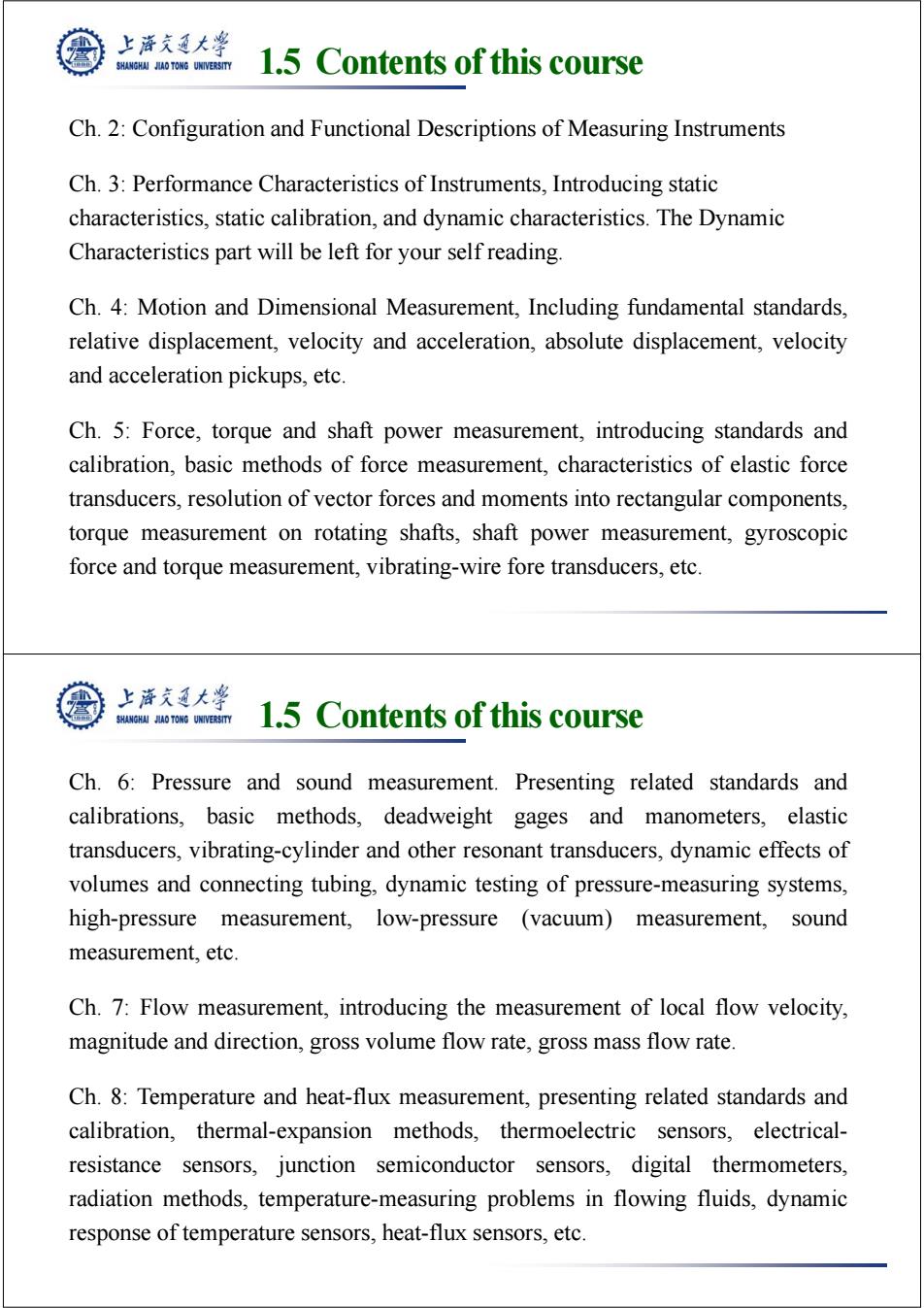正在加载图片...

上海通大学 SHANGHAI JIAO TONG UNIVERSITY 1.5 Contents of this course Ch.2:Configuration and Functional Descriptions of Measuring Instruments Ch.3:Performance Characteristics of Instruments,Introducing static characteristics,static calibration,and dynamic characteristics.The Dynamic Characteristics part will be left for your self reading. Ch.4:Motion and Dimensional Measurement,Including fundamental standards, relative displacement,velocity and acceleration,absolute displacement,velocity and acceleration pickups,etc. Ch.5:Force,torque and shaft power measurement,introducing standards and calibration,basic methods of force measurement,characteristics of elastic force transducers,resolution of vector forces and moments into rectangular components, torque measurement on rotating shafts,shaft power measurement,gyroscopic force and torque measurement,vibrating-wire fore transducers,etc. 上海文通大学 SHANGHAI JAO TONG UNIVERSITY 1.5 Contents of this course Ch.6:Pressure and sound measurement.Presenting related standards and calibrations,basic methods,deadweight gages and manometers,elastic transducers,vibrating-cylinder and other resonant transducers,dynamic effects of volumes and connecting tubing,dynamic testing of pressure-measuring systems, high-pressure measurement,low-pressure (vacuum)measurement,sound measurement,etc. Ch.7:Flow measurement,introducing the measurement of local flow velocity, magnitude and direction,gross volume flow rate,gross mass flow rate. Ch.8:Temperature and heat-flux measurement,presenting related standards and calibration,thermal-expansion methods,thermoelectric sensors,electrical- resistance sensors,junction semiconductor sensors,digital thermometers, radiation methods,temperature-measuring problems in flowing fluids,dynamic response of temperature sensors,heat-flux sensors,etc.1.5 Contents of this course Ch. 2: Configuration and Functional Descriptions of Measuring Instruments Ch. 3: Performance Characteristics of Instruments, Introducing static characteristics, static calibration, and dynamic characteristics. The Dynamic Characteristics part will be left for your self reading. Ch. 4: Motion and Dimensional Measurement, Including fundamental standards, relative displacement, velocity and acceleration, absolute displacement, velocity and acceleration pickups, etc. Ch. 5: Force, torque and shaft power measurement, introducing standards and calibration, basic methods of force measurement, characteristics of elastic force transducers, resolution of vector forces and moments into rectangular components, torque measurement on rotating shafts, shaft power measurement, gyroscopic force and torque measurement, vibrating-wire fore transducers, etc. 1.5 Contents of this course Ch. 6: Pressure and sound measurement. Presenting related standards and calibrations, basic methods, deadweight gages and manometers, elastic transducers, vibrating-cylinder and other resonant transducers, dynamic effects of volumes and connecting tubing, dynamic testing of pressure-measuring systems, high-pressure measurement, low-pressure (vacuum) measurement, sound measurement, etc. Ch. 7: Flow measurement, introducing the measurement of local flow velocity, magnitude and direction, gross volume flow rate, gross mass flow rate. Ch. 8: Temperature and heat-flux measurement, presenting related standards and calibration, thermal-expansion methods, thermoelectric sensors, electricalresistance sensors, junction semiconductor sensors, digital thermometers, radiation methods, temperature-measuring problems in flowing fluids, dynamic response of temperature sensors, heat-flux sensors, etc